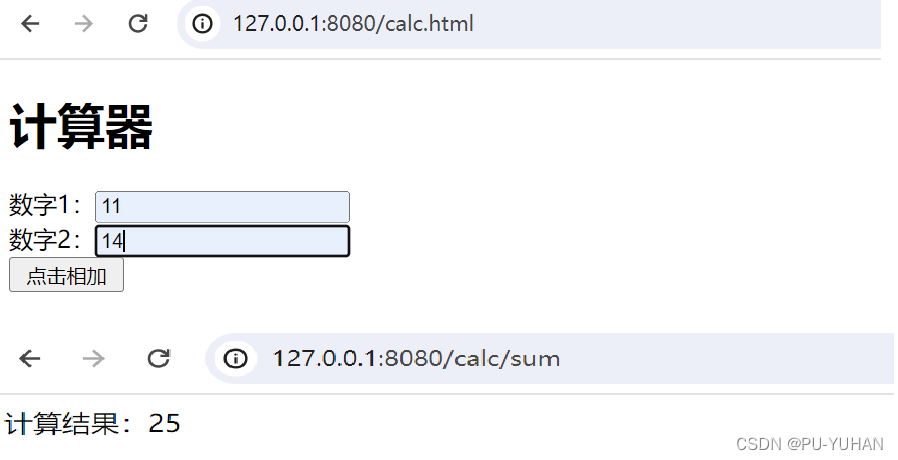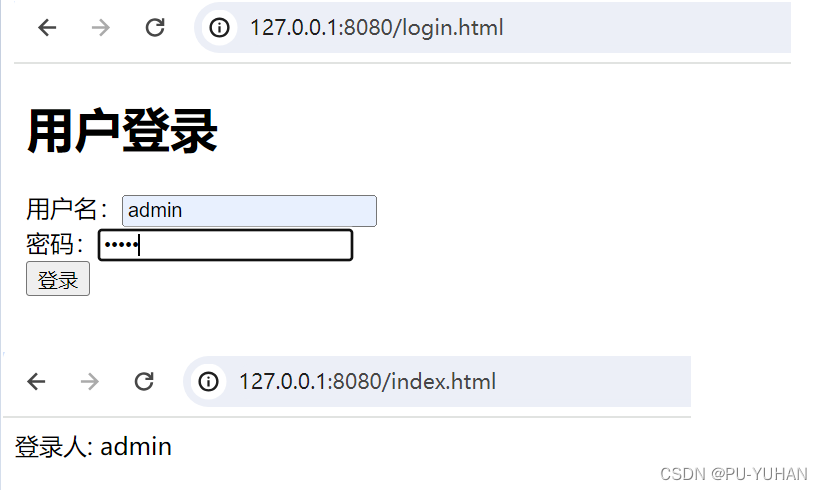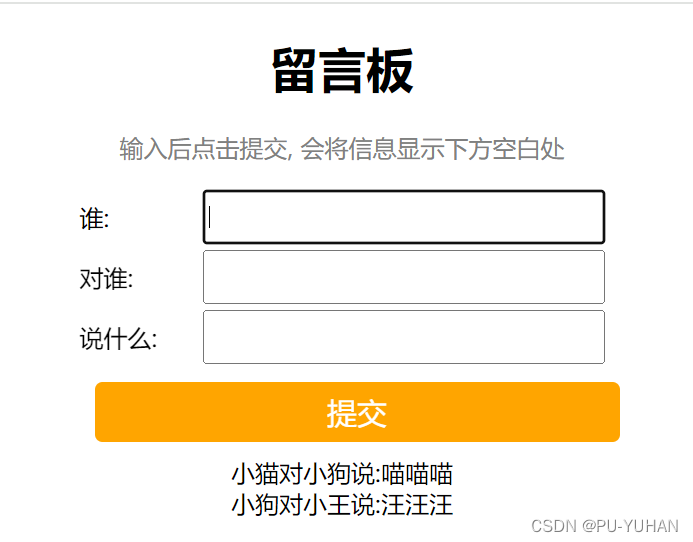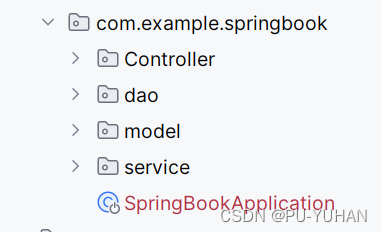❣博主主页: 33的博客❣
▶️文章专栏分类:JavaEE◀️
🚚我的代码仓库: 33的代码仓库🚚
🫵🫵🫵关注我带你了解更多进阶知识

目录
1.前言
上一篇文章,我们已经讲了Spring MVC请求部分的内容,这篇文章继续讲解。
2.响应
2.1返回静态界面
在之前的代码中,我们都是以@RestController来注解一个类,通过这个注解那么就表明返回的内容都为数据,所以前⾯使⽤的@RestController 其实是返回的数据,如果我们想返回一个界面可以用@Controller,如果要返回数据@Controller+@ResponseBody =@RestController。
java
@Controller
public class demo3 {
@RequestMapping("/index")
public String INDEX(){
return "/index.html";
}
} index.html内容
html
<!DOCTYPE html>
<html lang="en">
<head>
<meta charset="UTF-8">
<title>Title</title>
</head>
<body>
<h1>我是谁??</h1>
</body>
</html>
2.2返回数据
java
@Controller
public class demo3 {
@ResponseBody
@RequestMapping("/date")
public String DATA(){
return "/index.html";
}
} 
2.3返回HTML代码
java
@Controller
public class demo3 {
@ResponseBody
@RequestMapping("/date2")
public String DATA2(){
return "<h1>我是谁??</h1>";
}
}
3.综合练习
3.1计算器
java
package com.example.test1;
import org.springframework.web.bind.annotation.RequestMapping;
import org.springframework.web.bind.annotation.RestController;
@RestController
@RequestMapping("/calc")
public class Caculation {
@RequestMapping("/sum")
public String CAL(Integer num1,Integer num2){
Integer sum=num1+num2;
return "计算结果:"+sum;
}
}HTML
html
<!DOCTYPE html>
<html lang="en">
<head>
<meta charset="UTF-8">
<meta name="viewport" content="width=device-width, initial-scale=1.0">
<title>Document</title>
</head>
<body>
<form action="calc/sum" method="post">
<h1>计算器</h1>
数字1:<input name="num1" type="text"><br>
数字2:<input name="num2" type="text"><br>
<input type="submit" value=" 点击相加 ">
</form>
</body>
</html>结果

3.2用户登录
login界面
html
<!DOCTYPE html>
<html lang="en">
<head>
<meta charset="UTF-8">
<title>登录页面</title>
</head>
<body>
<h1>用户登录</h1>
用户名:<input name="userName" type="text" id="userName"><br>
密码:<input name="password" type="password" id="password"><br>
<input type="button" value="登录" onclick="login()">
<script src="https://cdn.bootcdn.net/ajax/libs/jquery/3.6.4/jquery.min.js"></script>
<script>
function login() {
$.ajax({
url:"/user/login",
type: "post",
data:{
username: $("#userName").val(),
password: $("#password").val()
},
// http响应成功
success:function(result){
console.log(result)
if(result==true){
//页面跳转
location.href = "index.html";
// location.assign("index.html");
}else{
alert("密码错误");
}
}
});
}
</script>
</body>
</html>index界面
html
<!doctype html>
<html lang="en">
<head>
<meta charset="UTF-8">
<meta name="viewport"
content="width=device-width, user-scalable=no, initial-scale=1.0, maximum-scale=1.0, minimum-scale=1.0">
<meta http-equiv="X-UA-Compatible" content="ie=edge">
<title>用户登录首页</title>
</head>
<body>
登录人: <span id="loginUser"></span>
<script src="https://cdn.bootcdn.net/ajax/libs/jquery/3.6.4/jquery.min.js"></script>
<script>
$.ajax({
url: "/user/index",
type: "get",
success:function(loginName){
$("#loginUser").text(loginName);
}
});
</script>
</body>
</html>后端代码:
java
package com.example.test1;
import jakarta.servlet.http.HttpSession;
import org.springframework.util.StringUtils;
import org.springframework.web.bind.annotation.RequestMapping;
import org.springframework.web.bind.annotation.RestController;
import org.springframework.web.bind.annotation.SessionAttribute;
@RestController
@RequestMapping("/user")
public class UserController {
@RequestMapping("/login")
public boolean login(String username, String password, HttpSession session){ if(!StringUtils.hasLength(username)||!StringUtils.hasLength(password)){
return false;
}
if("admin".equals(username)&&"admin".equals(password)){
session.setAttribute("username",username);
return true;
}
return false;
}
@RequestMapping("/index")
public String getusername(@SessionAttribute("username") String username){
return username;
}
}
4.3留言板
java
package com.example.test1;
import org.springframework.util.StringUtils;
import org.springframework.web.bind.annotation.RequestMapping;
import org.springframework.web.bind.annotation.RestController;
import java.util.ArrayList;
import java.util.LinkedList;
import java.util.List;
@RequestMapping("/message")
@RestController
public class MessageController {
private List<MessageInfo> messageInfos=new ArrayList<>();
@RequestMapping("/publish")
public Boolean publish(MessageInfo messageInfo){
System.out.println("接收到参数"+messageInfo);
//参数检验
if(!StringUtils.hasLength(messageInfo.getFrom())||!StringUtils.hasLength(messageInfo.getTo())||!StringUtils.hasLength(messageInfo.getSay())){
return false;
}
messageInfos.add(messageInfo);
return true;
}
@RequestMapping("/getlist")
public List<MessageInfo> getList(){
return messageInfos;
}
}
java
package com.example.test1;
import lombok.Data;
@Data
public class MessageInfo {
private String from;
private String to;
private String say;
}HTML主要代码:
html
<script>
$.ajax({
url: "/message/getlist",
type: "get",
success: function (messageInfos) {
var finalHtml = "";
for (var message of messageInfos) {
finalHtml += '<div>' + message.from + ' 对 ' + message.to + ' 说: ' + message.message + '</div>';
}
$(".container").append(finalHtml);
}
});
function submit() {
console.log("发布留言");
//1. 获取留言的内容
var from = $('#from').val();
var to = $('#to').val();
var say = $('#say').val();
if (from == '' || to == '' || say == '') {
return;
}
//发送ajax请求
$.ajax({
url: "/message/publish",
type: "post",
data: {
from: $('#from').val(),
to: $('#to').val(),
say: $('#say').val()
},
success: function (result) {
if (result) {
console.log(result)
//2. 构造节点
var divE = "<div>" + from + "对" + to + "说:" + say + "</div>";
//3. 把节点添加到页面上
$(".container").append(divE);
//4. 清空输入框的值
$('#from').val("");
$('#to').val("");
$('#say').val("");
}else{
alert("输入不合法");
}
}
});
5.应用分层
通过上⾯的练习,我们学习了SpringMVC简单功能的开发,但是我们也发现了⼀些问题
⽬前我们程序的代码有点"杂乱",然⽽当前只是"⼀点点功能"的开发.如果我们把整个项⽬功能完成呢?代码会更加的"杂乱⽆章"。
在之前我们学过,MVC把整体的系统分成了model(模型)、View(视图)和Controller(控制器)三个层次,也就是将⽤⼾视图和业务处理隔离开,并且通过控制器连接起来,很好地实现了表现和逻辑的解耦,是⼀种标准的软件分层架构。
目前现在更主流的开发方式是前后端分离:"的⽅式,后端开发⼯程师不再需要关注前端的实现, 所以对于Java后端开发者,⼜有了⼀种新的分层架构:把整体架构分为表现层、业务逻辑层和数据层,这种方式使代码高内聚低耦合。这种分层⽅式也称之为"三层架构"。
表现层 :就是展⽰数据结果和接受⽤⼾指令的,是最靠近⽤⼾的⼀层;
业务逻辑层 :负责处理业务逻辑, ⾥⾯有复杂业务的具体实现;
数据层 : 负责存储和管理与应⽤程序相关的数据
我们一般把表现层命名为Controller,业务逻辑层命名为Service,数据层命名为Dao

6.企业规范
1.类名使用大驼峰的形式
2.⽅法名、参数名、成员变量、局部变量统,使⽤⼩驼峰⻛格
- 包名统⼀使⽤⼩写,点分隔符之间有且仅有一个⾃然语义的英语单词
7.总结
学习SpringMVC,其实就是学习各种Web开发需要⽤的到注解@RequestMapping:路由映射, @RequestParam:后端参数重命名, @RequestBody:接收JSON类型的参数, @PathVariable: 接收路径参数,@RequestPart: 上传⽂件,@ResponseBody:返回数据 等等...
下期预告:Spring IOC&DI